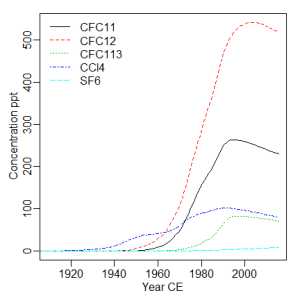Steve Goreham has written something for WUWT. That is enough to know it is going to be bad. How bad? This bad:
Another year has passed and that stubborn Ozone Hole over Antarctica refuses to go away. Data from the National Aeronautics and Space Administration (NASA) shows that the Ozone Hole for the fall maximum season grew 22 percent from 2014 to 2015. World consumption of Ozone Depleting Substances has been reduced to zero over the last three decades, but the Ozone Hole is as large as ever. Did humans really save the ozone layer?
Goreham argues that the persistence of the ozone hole after CFC emissions reduced suggests that the ozone hole is natural. In reality, it shows that CFC are persistent pollutants.
Contrary to Goreham’s argument, CFC emissions do not directly affect ozone, rather atmospheric CFC concentrations do. CFC concentrations integrate emissions since CFC emissions began, less cumulative degradation of CFC. Atmospheric CFC concentrations are available from the Carbon Dioxide Information Analysis Center.
CFC concentrations are falling now that emissions have (mostly) ceased, but due to the long atmospheric lifespan of these gases, concentrations have only fallen slightly. CFC12 concentrations, for example, have fallen by less than 5%. Thus, if the ozone hole was driven by CFC12 alone, we would expect it to have have decreased by about 5%, rather than shrinking to zero as Goreham naïvely expects.
With the long atmospheric lifespan of CFCs, Goreham will have many more opportunities to show his willful ignorance.



 @richardjtelford
@richardjtelford
I suspect that there is something analogous to GHG emissions. I’m seeing more and more people who seem to think that if we were to stop emitting, concentrations would drop rapidly back to pre-industrial levels. Wrong, of course, but it seems that that is pretty much the norm for WUWTers.
Yes, I thought about pointing out that this is analogous to CO2 concentrations vs emissions but decided to keep it short and simple.
Probably wise. They’re confused enough as it is 🙂
I first started using the term “willful ignorance” in these settings several years ago. But along with Dunning-Kruger it’s now become something I have to watch carefully to make sure I don’t overuse it. With a little luck and good sense, in a few years the faux skeptics will be considered as fringe as Young Earth creationists are now. Not without having caused a significant amount of damage first, unfortunately.
It’s a good thing Dupont didn’t have the same clout or financial incentives to keep CFCs in production as fossil fuel companies do with their products or we’d still be hearing arguments that the ozone depletion is natural, or that we can’t be sure, or that it’s too economically disruptive to pull them out of industrial use… and the ozone layer would be that much more damaged.
Actually, the world has been saved by an internal committee of Dupont that have chosen chlorine compound instead of bromine, because chlorine was slightly cheaper. If they had made the opposite chose, the accumulated concentration of bromine would have destroyed the ozone layer even before someone mange to figure out what was happening.
The game usually is to read the WUWT comments and see how many people point out the obvious, but get shouted down. This time it looks like *no one* has pointed it out (https://archive.is/937G9) which is shameful; even Ferdinand Engelbeen who is sometimes a voice of sanity there gets it wrong.
There were only three comments when I read it, so I thought it unfair to do this. Now there are 81 comments and it is not until comment 79 that Ferdinand Engelbeen calls Goreham out.
OK, so I’m pleased to see FE hasn’t totally lost it. I’d only seen up to 69. I think you’re being generous with “calls Goreham out”; what FE writes is the mildest possible way of phrasing it, and doesn’t even say what he clearly must know, that CFC concs haven’t really declined.
GoatGuy spoke up before Engelbeen or Hausfather, and drew some fire for it.
Zeke Hausfather has now done a rather better job.
It’s not CFC concentrations, it’s CFC concentration in the stratosphere. The >5 year delay between emissions at the surface and the CFCs making it into the stratosphere means that the stratospheric concentration will always lag the atmospheric concentrations.
FWIW you have to pay attention to the spectroscopy of the CFCs. For them to dissociate and form Cl atoms, the CFCs have to actually get above the ozone layer where there is enough < 230 nm UV and then the Cl atoms have to mix back down into the ozone layer in the stratisfied stratosphere.
Anyone surprised to see David Siegel (see ATTP’s site for more info) also has fallen for Goreham’s nonsense? Crank magnetism.
Hook, line, and sinker